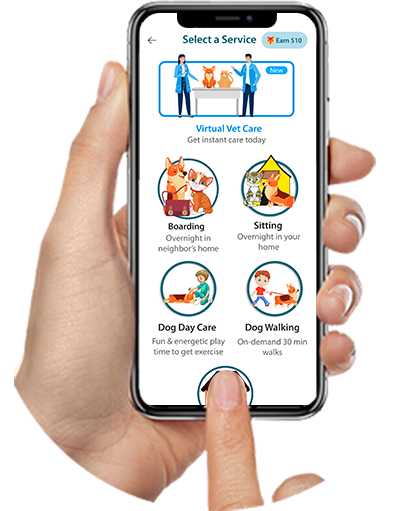
Online Vet Thornton CO
Pet Lovers rejoice as your favorite Veterinary app is now live in your city. Bid goodbye to long waits and emergency pet care because now you can get personalized advice, care suggestions, and prompt responses for your pets. Meet vets who carry the same love and passion to serve animals. Enjoy unmatched convenience by connecting with a dedicated animal health professional now.

What is the process for receiving veterinary care online?
-
- Open the application and start a chat with a certified vet.
- Talk to the vet regarding the concern that is faced by your little one or have a regular chat about your pet’s health
- You will be presented with a personalized plan for your pet as soon as the expert assesses your furry friend’s condition.
-


What Sets Us Apart
-
 Unlimited access and follow ups for continuous pet care
Unlimited access and follow ups for continuous pet care
-
 On demand visits for urgent issues 24/7
On demand visits for urgent issues 24/7
-
 Expert advice on healthcare, nutrition, behavior and all your pet needs!
Expert advice on healthcare, nutrition, behavior and all your pet needs!

Why do we need an online vet platform for pets?
-
- Reduced stress: Pets often experience higher levels of stress and anxiety when visiting a traditional veterinary clinic due to the unfamiliar sights, sounds, and smells. CuddlyTails is an online platform that allows them to receive care from the comfort of their home environment, minimizing stress and potential complications.
- Video and photo consultation: CuddlyTails allows owners to share videos or photos of their pets, enabling the veterinarian to observe the pet’s behavior, mobility, and any potential issues in their familiar surroundings. This can provide valuable insights for diagnosis and treatment.
- Accessibility to specialists: CuddlyTails provides access to a network of specialists, who can offer expert guidance on caring for pets and addressing any unique challenges they may face.
- Personalized advice: Through consultations and detailed discussions with the owner, CuddlyTails can offer personalized advice on creating a safe and enriching environment for pets, including tips on litter box placement, feeding routines, and navigating the home.
Antifreeze Poisoning in Dogs
-
Antifreeze poisoning is a critical condition in dogs caused by the ingestion of ethylene glycol, a toxic substance commonly found in antifreeze products. This condition can lead to severe health complications, including kidney failure and death.
Overview
- Definition: Antifreeze poisoning occurs when a dog ingests ethylene glycol, leading to toxic effects primarily on the central nervous system and kidneys.
- Common Sources: Ethylene glycol is found in:
- Automotive antifreeze
- Windshield de-icers
- Hydraulic brake fluids
- Some paints and solvents
Symptoms
The symptoms of antifreeze poisoning can be categorized into three stages based on the time elapsed since ingestion:
Stage 1 (30 minutes to 12 hours post-ingestion)
- Lethargy: General weakness and decreased activity.
- Neurological Signs: Lack of coordination, staggering gait (ataxia), vomiting, and increased thirst and urination.
- Hypothermia: Low body temperature may be observed.
Stage 2 (12 to 24 hours post-ingestion)
- Temporary Improvement: Dogs may appear to improve as some external symptoms lessen; however, internal damage continues.
- Dehydration: Increased heart rate and respiratory rate due to worsening internal conditions.
Stage 3 (36 to 72 hours post-ingestion)
- Severe Kidney Damage: Swollen kidneys lead to reduced urine production or complete kidney failure.
- Re-emergence of Symptoms: Signs such as vomiting, lethargy, seizures, and potentially coma may occur as the dog’s condition deteriorates.
Causes
Lead poisoning primarily occurs through:
- Ingestion of Ethylene Glycol: Dogs are attracted to antifreeze due to its sweet taste. Even small amounts can be toxic—approximately half a teaspoon per pound of body weight can be fatal.
- Environmental Exposure: Dogs may lick antifreeze spills from driveways or roads or ingest it from contaminated water sources.
Diagnosis
Diagnosis typically involves:
- Veterinary Examination: A thorough physical assessment and history of potential exposure.
- Blood Tests: Initial tests may not show elevated levels immediately after ingestion; however, later tests may reveal metabolic acidosis and elevated kidney markers.
- Urinalysis: Checking for calcium oxalate crystals that typically appear after ethylene glycol metabolism.
Treatment Options
Immediate treatment is crucial for improving outcomes:
- Inducing Vomiting: If ingestion was recent (within a few hours), vomiting may be induced. However, this is often not effective due to rapid absorption.
- Antidotes:
- Fomepizole (4-methylpyrazole): The preferred antidote that inhibits the metabolism of ethylene glycol into toxic metabolites.
- Ethanol: An alternative antidote that competes with ethylene glycol for metabolism in the liver.
- Supportive Care:
- Administration of intravenous fluids to correct dehydration and promote kidney function.
- Monitoring electrolyte levels and blood pH during treatment.
Prognosis
The prognosis for dogs with antifreeze poisoning largely depends on:
- Timing of Treatment: Early intervention significantly improves survival rates; treatment is most effective within the first few hours after ingestion.
- Severity of Symptoms: Dogs that progress to severe kidney failure have a poorer prognosis.
Prevention
Preventive measures include:
- Proper Storage: Store antifreeze securely out of reach of pets and children.
- Prompt Cleanup: Clean up any spills immediately to prevent accidental ingestion.
- Awareness: Be vigilant during colder months when antifreeze use is more common.
Conclusion
Antifreeze poisoning is a life-threatening emergency that requires immediate veterinary attention. If you suspect your dog has ingested antifreeze or shows symptoms consistent with poisoning, contact your veterinarian or an emergency animal clinic without delay. Early diagnosis and treatment are crucial for improving outcomes and saving your pet’s life.




 Unlimited access and follow ups for continuous pet care
Unlimited access and follow ups for continuous pet care 


